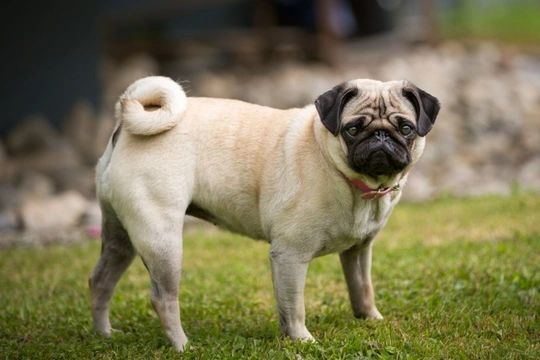
Breed Club Hemivertebrae Testing
Hemivertebrae is the name given to a condition of the canine conformation that leads to the signature corkscrew tail that can be seen in various different dog breeds, most notably the pug. The tail of such breeds is curled because of a unique formation of the spine of such breeds, which is in fact a congenital deformity, leading to the spine in whole or in part fusing in a twisted fashion, rather than being straight as is the case in normal dog spines.
The congenital deformity that causes a corkscrew or curled tail often has no other effect on the dog, but in some cases, it can lead to compression of the spine itself, and subsequently, cause pressure or twisting of the nerves too, which can of course be very painful and also, affect normal movement.
Hemivertebrae is common in smaller dog breeds with brachycephalic faces, and as mentioned, whether or not the condition leads to problems for the dog as well as the signature curled tail depends on a range of factors such as the degree of deformity and what area of the spine it affects.
Because the condition is prevalent in certain breeds of dog, breed clubs that oversee the welfare of potentially affected breeds often recommend pre-breeding screening for the condition, to ensure that only healthy dogs that are not affected by the condition are used for breeding.
In this article, we will look at breed club hemivertebrae testing for dogs in more detail, including what sort of dogs can be affected by the condition, how testing is performed, and how to tell if your own dog should be tested. Read on to learn more.
More about hemivertebrae
Hemivertebrae is congenital condition that is the cause of some debate, because the curled tail of breeds like the pug is part of the accepted breed standard, but the condition can also potentially lead to a range of problems as well as the curled tail itself. For this reason, the potential problems that it can cause is carefully monitored, to ensure that the problematic form of the condition and the more acute forms of hemivertebrae are not present in dogs used for breeding.
In dogs affected by the condition, symptoms can include hind limb weakness, faecal incontinence and potentially pain, which usually becomes apparent not long after the puppies are born and begin to become mobile, and which then worsens with age as the spine grows and develops.
What sort of dogs can be affected by the condition?
Any dog breed that has the signature curled tail as part of their breed standard, or that inherits the curled tail as part of cross breeding or selective breeding may potentially be diagnosed with hemivertebrae, but it is important to note that in the vast majority of affected dogs, it leads to a curled tail but no other problems.
The pug dog breed is the one that is most widely affected by hemivertebrae, and within which the condition is most likely to be problematic, and as such the pug breed club strongly advocates for pre-breeding screening for dogs of the breed.
The French bulldog is another breed that can potentially develop hemivertebrae, as can any other breed with a curled tail.
How can dogs be tested for the condition?
The pug breed club advises that any pugs intended to be used for breeding should be tested first, to ensure that they will not pass on a problematic form of the condition to their offspring. Adult pugs that have normal movement and no problems do not need to be tested unless they will be bred from.
In order to get your dog tested, you will need to find a veterinary radiographer that can take x-rays of your dog’s spine, as because the condition is a congenital malformation rather than a single-strand DNA abnormality, DNA testing will not return a conclusive result.
Because the radiographer may need to take several slides of the spine in different positions and this involves the dog laying out and remaining still, this usually requires a general anaesthetic, and very few veterinary radiographers will wish to perform the x-rays without the dog being anaesthetised. Sedation is generally considered inappropriate for the x-rays, because sedating brachycephalic breeds comes with more risks that sedating other dogs, and so a general anaesthetic is usually the preferred method of taking good x-ray slides in one go.
Once the slides have been taken, a veterinary radiographer can make an assessment on the condition of the spine, and whether or not it is causing any problems, or likely to cause problems in offspring if the dog is used for breeding.
The degree of twisting of the spine can vary from case to case, and whilst some dogs may return a result of some twisting, this is not necessarily enough to affect their quality of life, although they still should not be used for breeding, as the condition can still be passed on.



